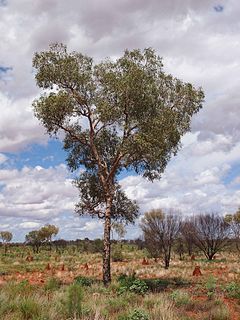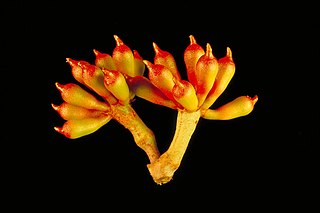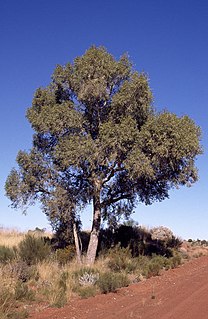
Corymbia gummifera, commonly known as red bloodwood, is a species of tree, rarely a mallee, that is endemic to eastern Australia. It has rough, tessellated bark on the trunk and branches, lance-shaped adult leaves, flower buds in groups of seven, creamy white flowers and urn-shaped fruit.

Corymbia polycarpa, also known as the long-fruited bloodwood or small-flowered bloodwood, is a species of tree that is endemic to northern Australia. Indigenous Australians of different language groups have different names for the tree. The Nungali peoples know the tree as narrga or gunjid, the Mulluk-Mulluk know it as dawart, the Yangman know it as bodog, the Gurindji peoples as jadburru and the Wagiman as jagatjjin. It is a medium-sized tree with rough, tessellated bark on the trunk and branches, lance-shaped to curved adult leaves, flower buds in groups of seven or nine, white or cream-coloured flowers and barrel-shaped fruit.

Corymbia opaca, also known as the desert bloodwood, is a species of tree that is endemic to northern Australia. It has rough bark on part or all of the trunk, lance-shaped leaves, club-shaped flower buds and urn-shaped fruit. Several parts of this plant are used by Aboriginal Australians in traditional medicine.

Corymbia terminalis, also known as tjuta, joolta, bloodwood, desert bloodwood, plains bloodwood, northern bloodwood, western bloodwood or the inland bloodwood, is a species of small to medium-sized tree, rarely a mallee that is endemic to Australia. It has rough, tessellated bark on some or all of the trunk, sometimes also on the larger branches, smooth white to cream-coloured bark above, lance-shaped adult leaves, flower buds in groups of seven, white flowers and urn-shaped fruit.

Corymbia ptychocarpa, commonly known as the swamp bloodwood or spring bloodwood, is a species of tree that is endemic to northwestern Australia. It has rough bark on the trunk and branches, broadly lance-shaped adult leaves, flower buds in groups of seven, creamy yellow, pink or red flowers, and barrel-shaped, ribbed fruit.

Corymbia zygophylla, commonly known as the Broome bloodwood, is a species of small tree or a mallee that is endemic to Western Australia. It has rough, tessellated to fibrous bark on the trunk and branches, a crown of juvenile heart-shaped to lance-shaped, stem-clasping leaves, flower buds in groups of three or seven, white flowers and urn-shaped to shortened spherical fruit.
Corymbia arnhemensis, commonly known as the Katherine Gorge bloodwood, is a species of slender tree that is endemic to the Top End of the Northern Territory. It has rough bark on some or all of the trunk, sometimes the larger branches, smooth bark above, lance-shaped to curved adult leaves, flower buds in groups of seven, white flowers and urn-shaped fruit.

Corymbia bleeseri, commonly known as the glossy-leaved bloodwood or the smooth-stemmed bloodwood, is a species of tree that is endemic to northern Australia. It has thin, rough bark on part or all of the trunk, smooth bark above, lance-shaped to curved adult leaves, flower buds in groups of seven, creamy white flowers and barrel-shaped fruit.

Corymbia chippendalei, commonly known as the sand-dune bloodwood or sandhill bloodwood, is a species of small tree or a mallee that is endemic to desert country in central Australia. It has rough bark on part or all of the trunk, lance-shaped adult leaves, flower buds in groups of seven, white flowers and shortened spherical fruit.
Corymbia deserticola is a species of straggly tree, a mallee or a shrub that is native to Western Australia and the Northern Territory. It has rough, tessellated bark on the trunk and branches, mostly sessile, heart-shaped leaves arranged in opposite pairs, flower buds in groups of seven on each branch of a peduncle, creamy yellow flowers and urn-shaped to shortened spherical fruit.

Corymbia ferriticola, commonly known as the Pilbara ghost gum, is a species of tree or a mallee that is endemic to Western Australia. It has smooth bark, lance-shaped adult leaves, flower buds in groups of seven, creamy white flowers and shortened spherical to cylindrical fruit.

Corymbia ferruginea, commonly known as the rusty bloodwood, is a species of tree that is endemic to northern Australia. It has rough, tessellated bark on the trunk and branches, a crown of sessile juvenile leaves, flower buds in groups of three or seven, pale creamy yellow flowers and urn-shaped fruit.

Corymbia foelscheana, commonly known as the broad-leaved bloodwood, fan-leaved bloodwood or smooth-barked bloodwood, is a species of small tree that is endemic to northern Australia. It has thin, rough, tessellated bark on some or all of the trunk, smooth bark above, broadly egg-shaped to broadly lance- shaped adult leaves, flower buds usually in groups of seven, creamy white flowers and urn-shaped fruit.

Corymbia grandifolia, commonly known as the cabbage gum, large-leaved cabbage gum and the paper-fruited bloodwood, is a species of tree that is endemic to northern Australia. It has smooth bark, egg-shaped to broadly elliptic to lance-shaped adult leaves, flowers buds in groups of three or seven, creamy white flowers and cup-shaped to cylindrical fruit.
Corymbia hamersleyana is a species of small tree or mallee that is endemic to the Pilbara region of Western Australia. It has rough, flaky bark on part or all of the trunk, smooth cream-coloured bark above, lance-shaped adult leaves, flowers buds in groups of seven or nine, creamy white flowers and urn-shaped fruit.
Corymbia lenziana, commonly known as the narrow-leaved bloodwood, is a species of small tree that is endemic to Western Australia. It has rough, tessellated bark on the trunk and branches, narrow lance-shaped to linear leaves, flower buds in groups of seven, white flowers and shortened spherical fruit.
Corymbia porrecta, commonly known as the grey bloodwood, is a species of small tree that is endemic to the Northern Territory. It has rough, tessellated bark on the trunk and branches, broadly lance-shaped to egg-shaped adult leaves, flower buds usually in groups of seven, creamy white flowers and urn-shaped to barrel-shaped fruit.
Corymbia stockeri, commonly known as the blotchy bloodwood, is a species of small tree that is endemic to Cape York Peninsula in Queensland. It has rough, tessellated bark on the trunk and branches, lance-shaped adult leaves, flower buds in groups of seven, creamy white flowers and barrel-shaped to urn-shaped fruit.

Corymbia umbonata, commonly known as the rusty bloodwood, is a species of tree that is endemic to the Top End of the Northern Territory. It has thin, rough bark on the trunk, often also the branches, lance-shaped or curved adult leaves, flower buds in groups of seven, creamy white flowers and urn-shaped fruit.

Corymbia watsoniana, commonly known as the large-fruited yellowjacket, is a species of tree that is endemic to Queensland. It has rough, tessellated bark on the trunk and branches, egg-shaped to broadly lance-shaped adult leaves, flower buds in groups of seven, creamy white flowers and barrel-shaped or urn-shaped fruit.














